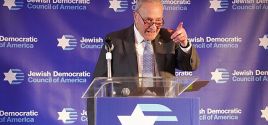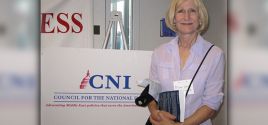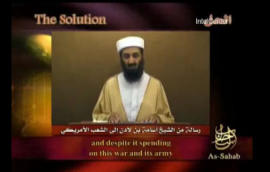Researcher: Bin Laden's beard is real, video is notby Robert VamosiCNet Sep. 14, 2007 |
Popular 
Netanyahu Cries 'Antisemitism' After International Criminal Court Issues Warrant for His Arrest

Trump Nominates Pam Bondi for Attorney General

Schumer Moves to Silence Criticism of Israel as Hate Speech With 'Antisemitism Awareness Act'

FBI Pays Visit to Pro-Palestine Journalist Alison Weir's Home

Matt Gaetz Withdraws from Consideration as Attorney General
  On the Friday before the sixth anniversary of 9/11, Osama bin Laden appeared in a new video, his first since prior to the U.S. presidential elections in 2004. In analyzing the video, Neal Krawetz of Hactor Factor, an expert on digital image forensics, said in his latest blogs that the video contained many visual and audio splices, and that all of the modifications were of very low quality. On the Friday before the sixth anniversary of 9/11, Osama bin Laden appeared in a new video, his first since prior to the U.S. presidential elections in 2004. In analyzing the video, Neal Krawetz of Hactor Factor, an expert on digital image forensics, said in his latest blogs that the video contained many visual and audio splices, and that all of the modifications were of very low quality. Most striking is bin Laden's beard, which has been gray in recent images. For this video it is black. "As far as my tools can detect, there has been no image manipulation of the bin Laden portion of the image beyond contrast adjustment. His beard really does appear to be that color." The Washington Post has the full video here. Krawetz says the inner frame of bin Laden was resaved at least twice, and not at the same time. The images show fine horizontal stripes on bin Laden and a background indicating these came from interlaced video sources. In contrast, the text elements, such as the As-Sahab logo, appear to be from non-interlaced sources. The September 7 video shows bin Laden dressed in a white hat, white shirt and yellow sweater. Krawetz notes "this is the same clothing he wore in the 2004-10-29 video. In 2004 he had it unzipped, but in 2007 he zipped up the bottom half. Besides the clothing, it appears to be the same background, same lighting, and same desk. Even the camera angle is almost identical." Krawetz also notes that "if you overlay the 2007 video with the 2004 video, his face has not changed in three years--only his beard is darker and the contrast on the picture has been adjusted." More important though are the edits. At roughly a minute and a half into the video there is a splice; bin Laden shifts from looking at the camera to looking down in less than 1/25th of a second. At 13:13 there is a second, less obvious splice. In all, Krawetz says there are at least six splices in the video. Of these, there are only two live bin Laden segments, the rest of the video composed of still images. The first live section opens the video and ends at 1:56. The second section begins at 12:29 and continues until 14:01. The two live sections appear to be from different recordings "because the desk is closer to the camera in the second section." Then there are the audio edits. Krawetz says "the new audio has no accompanying 'live' video and consists of multiple audio recordings." References to current events are made only during the still frame sections and after splices within the audio track." And there are so many splices that I cannot help but wonder if someone spliced words and phrases together. I also cannot rule out a vocal imitator during the frozen-frame audio. The only way to prove that the audio is really bin Laden is to see him talking in the video," Krawetz says. Another bin Laden video was released on September 11 and was much more straightforward. There was a still image of the black-bearded bin Laden (oddly, using a frame not used in the previous video), and then, as has been a tradition at al-Qaida , there was a long, unedited video of a statement read by Azzam Al Amriki, also known as American-born Adam Pearlman, who is currently being sought for treason and thought to be living in Pakistan. That doesn't mean the 9/11-released video wasn't doctored. Click here and mouse over the image to see Krawetz's 75 percent error level analysis of one image. The white frame around Azzim reveals that his video was composited against the drawing of the World Trade Center being attacked. As Krawetz presented at this year's Black Hat conference in Las Vegas, al-Qaida has a history of doctoring background either to present propaganda or simply to disguise locations. In a separate interview, Krawetz talks with CNET News.com about some of the tools he used in his analysis. |



